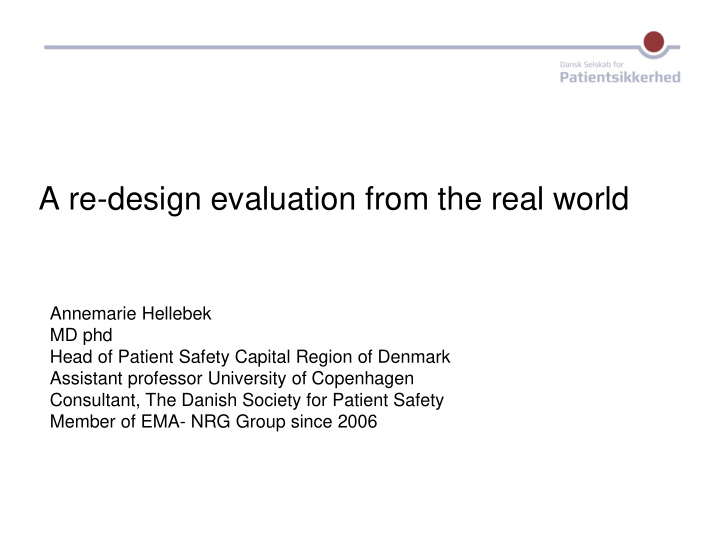



A re-design evaluation from the real world Annemarie Hellebek MD phd Head of Patient Safety Capital Region of Denmark Assistant professor University of Copenhagen Consultant, The Danish Society for Patient Safety Member of EMA- NRG Group since 2006
Evaluation of a new design • The medilabel safety design was implemented for taxpayers´ money in 2008 after a design competition – Make the most safe label design in the world for generic hospital medicines – Use all available information including NPSA hand book, interviews with staff and visits to hospitals • The winning design ”MEDILABEL” reached the finals of a global contest ”Index Awards” in ”design for life” • Evalaution 2012 – Simulation study – Reported errors study
Nine features in the design • New Font • Code for dilution Clean up the label Code for danger • • • Strength in upper left • Code for strenght corner Space for specific • • Abilty to make guidance text changes • Space for ATC code (used for storage) More details www.amgros.dk
Simulation study
General features – post simulation standardized interview • Clear and easy to read font • Identical construction principle across labels • Improved pattern recognition • Bar code compatible with scanners! • Some colours have more than one meaning • Dilution stripe has more than one function • ATC Code largely unknown • Many combinations of codes are difficult to remember
Reported errors study 3764 medication errors with relevant generic • names 951 unique dispensing errors with relevant generic – names – 165 unique dispensing errors involving one or more drugs from SAD
951 unique dispensing errors with relevant generic names Others Calculation No or Application Total Misinterpretate errors delayed of wrong label dispensing label at syringe/bag 48 (11%) 38 (9%) 15 (3%) 72 (17%) 2007 262 (60%) 435 2010 254 (49%) 62 (12%) 83 (16%) 18 (3%) 99 (19%) 516
165 dispensing errors involving at least one drug from SAD No over all differences in harm to patient • No over all differences in errors related to • the codes before and after implementation of new design
Conclusion • Dispensing errors related to misinterpretation of labels remain a problem despite using the best hand book and the best designers • Testing medication labels in simulation contexts provided information on what worked and what should be optimized in the label. Focus areas for implementation could be identified • Using reported medication errors as a data source for this type of research is possible but improved quality of the data and inclusion of data identifying the exact product is necessary. • Research in proper label design remains a relevant topic
• Cooperation between Amgros and the Danish Society for Patient Safety – Hanne Fischer , Marianne Hald Clemmensen, Simon Schytte Hansen, Annemarie Hellebek • The Danish Institute for medical simulation did the simulation study – Peter Dieckmann, Pina Kunstek • The National Learning office helped with access to reported errors • The study was supported by a grant from TrygFonden
Recommend
More recommend